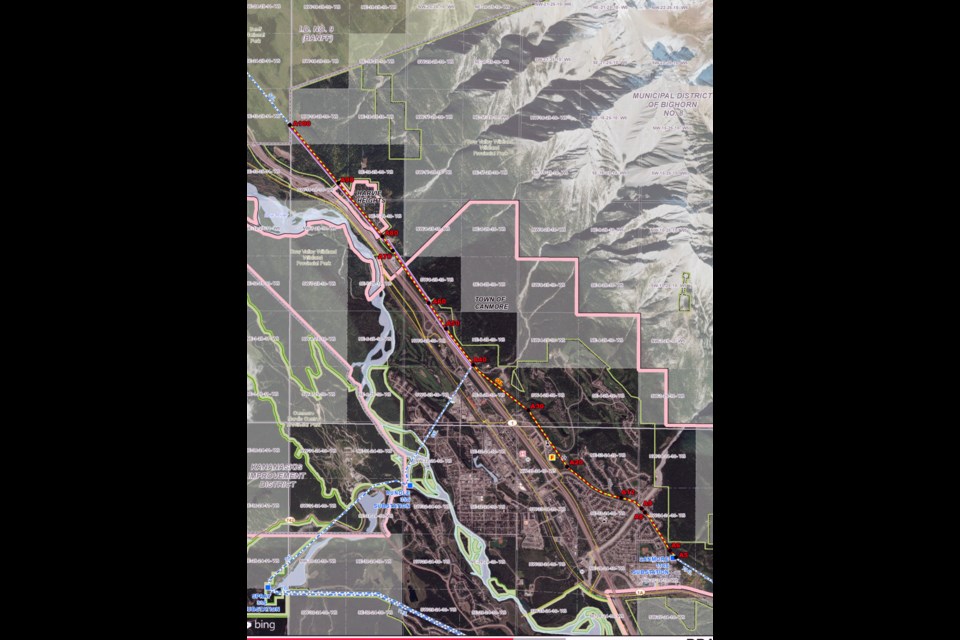CANMORE – A lengthy stretch of aging power line will likely soon be replaced within the Town of Canmore, but it’s unlikely the line will be buried and out of sight for residents.
The proposed project would rebuild an eight-kilometre stretch between the Canmore substation to the boundary of Banff National Park. An AltaLink report stated plans to rebuild in the Banff section of the line are only in the early stages.
However, the significant extra costs that come with a power line being buried will likely see it remain in the skyline.
“People like the idea of not seeing a line. We would consider burying lines, but if we’re going to do that the cost is significantly more than leaving them overhead,” said Steven Day, senior right-of-way planner with AltaLink.
“It’s generally in the range of 10 times more for the project, so those additional costs – since we’re doing this on behalf of the ratepayers – we would ask the stakeholder to put up their remaining portion of the cost to underground the line.”
Day said for every 100 metres of power line above ground it costs about $150,000, whereas the price tag could potentially hit $1.5 million, for every 100 metres, if it’s beneath the ground.
He said there are times when a line has to be buried, including one stretch in the Three Sisters area or near highways and major roads, but it’s more common to be above ground.
“It’s a fairly expensive process, so we don’t do it unless there’s a need to do it or someone wants to pay for it.”
Mayor Sean Krausert noted he had heard from a resident in the Elk Run area who asked about the potential of burying the power lines. Day added they will likely be asking Fortis to pay for a short stretch of lines to be buried in the Elk Run Boulevard area.
Though appearing before Town council, the decision is in the hands of the Alberta Utilities Commission after the final application is submitted.
The AltaLink report said the consultation period would continue until April 2022 and it is estimated the application will be made in May 2022. If approved, construction would begin in June 2023 and be completed in December 2024.
The existing 54L line – which stretches the length of Canmore and runs into Banff National Park – was built in 1943.
AltaLink held a virtual information session Nov. 3 and offered one-on-one meetings with residents who are in the area of the proposed transmission line.
The report also highlighted AltaLink has worked with Alberta Wildfire to find and mitigate high-risk fire areas and some trees may be removed.
AltaLink added environmental and geotechnical surveys are also ongoing before any work is done.
During the rebuild, a temporary line – also called a by-pass – will be built to ensure electricity is maintained.
The existing monopole or H-frame poles are between 15 to 20 metres in height and spaced about 120 to 200 metres apart. The proposed heights are between 20 to 30 metres in height and will be about 140 metres from one another.
The proposed build would see the poles built of self-weathering steel and mainly be monopole, but some H-frames may be required, according to the AltaLink report.
The height of the poles are determined by the need in the area they are placed. However, once the plans are finalized more information can be provided on the height in specific areas.
“It might be good to know overall in terms of the project how many of the poles will be taller and what locations,” Coun. Tanya Foubert said. “I’m just predicting viewscapes might become an important value for our residents.”
Day said taller heights are usually needed at crossings and the heights vary depending on each placement.
“We’re trying to do a balance on the length of the spans because you try to minimize your structures as much as possible when you’re engineering,” Day said. "In the case of Canmore, we also want to minimize the number of trees that we’re having to remove, so you want to make the line as tall as possible. At the same time, we don’t want to have giant structures all the way along. We’re trying to achieve a balance as we go along in Canmore.”
Correction: The print edition of this article in the Nov. 25 Outlook incorrectly stated the 54L line would be renamed 113L if approved by the Alberta Utilities Commission (AUC). The 113L line is a separate project that has been approved by the AUC.




